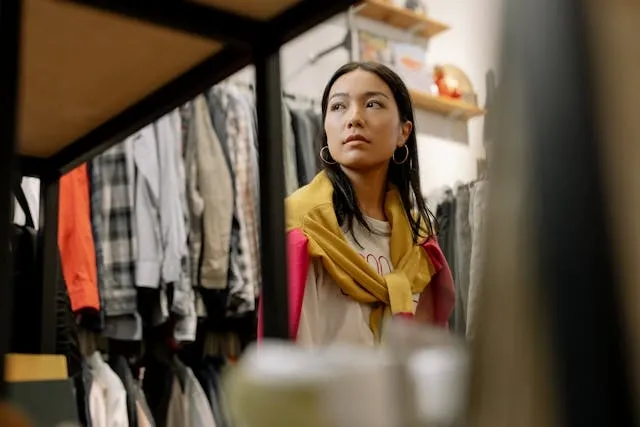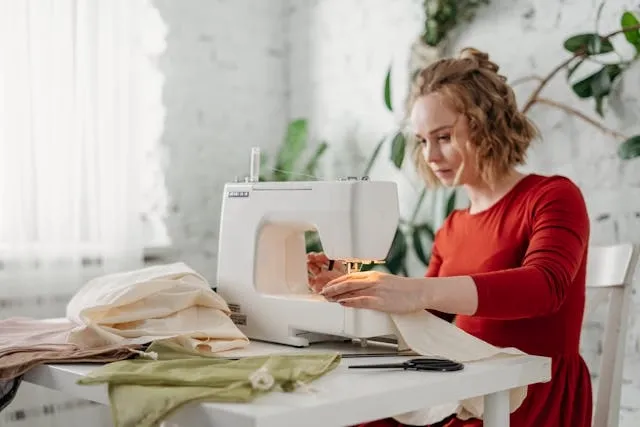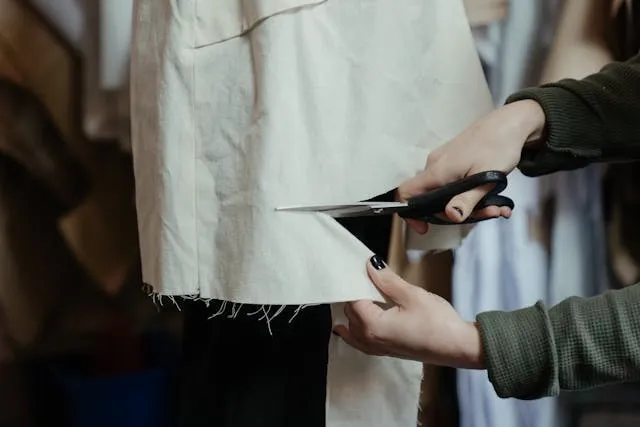What Is Upcycling Clothes? (Costs, Benefits, Availability And Trends)
Upcycling clothes is an eco-friendly fashion principle that transforms old or unused garments into something new and stylish. In this post, we explore the concept of upcycling, including the costs and benefits involved. We’ll also look into the latest upcycling trends, highlighting how this sustainable practice reduces waste and encourages creativity and personal expression. Discover how upcycling can breathe new life into your wardrobe and contribute to a more sustainable fashion industry.

Key Takeaways
- Upcycling clothes is a great way to transform old garments into new, stylish pieces, reducing waste and promoting sustainable fashion in the process.
- The process offers financial savings and allows you to use a little creative expression. It is a sustainable alternative to fast fashion, which causes significant environmental harm.
- The growing popularity of upcycling is mainly driven by environmental awareness and social media influencers. Major fashion brands are even incorporating it into their collections.
- We supply high-quality custom patches in a range of styles and materials that you can incorporate into your upcycled creations to make them even more unique and personal.
Table of contents
-
What Is Upcycling Clothes?
-
Benefits Of Upcycling Clothes
-
What Does It Mean When A Product Is Upcycled?
-
Difference Between Upcycled, Recycled, And Reused Clothing?
-
Are Upcycled Clothes Ethical?
-
Are Upcycled Clothes Worth The Cost?
-
What Are The Best Techniques For Upcycling Clothes?
-
Why Should I Upcycle My Clothes?
What Is Upcycling Clothes?
In fashion, the definition of upcycling is transforming old garments and other fabric products into something new. For example, a skilled sewer could transform an old blouse with a floral pattern into a skirt for the summertime. This differs from recycling, which is the process of extracting the raw materials from something to reuse them for a new product.
The fashion industry is notorious for creating a lot of waste. Moreover, the processes of manufacturing new garments use a lot of energy - the fashion industry is responsible for 10% of the world’s carbon dioxide emissions. Upcycling could reduce demand for new clothing, helping limit manufacturing in the long term to bring those CO2 emissions down.
Upcycling also offers:
- Financial benefits: By upcycling old garments, you save money against buying replacements.
- Creative benefits: Upcycling is a creative process that is very rewarding and enjoyable.
When you upcycle old clothing, you can then accessorize with things like custom iron-on patches to make the new look even more unique.

Are Upcycling Clothes Sustainable?
Upcycling clothing is generally viewed to be a sustainable practice. This is because it doesn’t require the use of new resources from the planet. It reuses old textiles rather than relying on brand new fabrics, which take a lot of energy, water, and raw materials to produce. Many fashion brands are beginning to accept returns of old clothing for the purposes of upcycling as part of their sustainability goals.
Upcycling is an emerging trend in fashion. The creativity involved can bring about some incredible creations that otherwise wouldn’t exist. And the industry is aware that, if it was a country, it would be one of the nations with the highest carbon emissions in the world. So brands are embracing upcycling as a solution to make their industry more sustainable.
Benefits Of Upcycling Clothes
Upcycling clothes reduces the fashion industry’s reliance on several harmful practices, meaning it is a far more sustainable solution. Here are some ways it benefits the planet:
- Less consumption of raw materials: The production of cotton and similar textile threads requires a lot of land for growing the plants, which contributes to deforestation.
- Reduced energy consumption: The processes involved in spinning raw materials, creating fabrics, and transforming them into clothing consume lots of energy, resulting in a uge amount of carbon emissions. Transporting fabrics and garments around the world exacerbates this problem.
- Minimizing water consumption: It’s estimated that the fashion industry uses around 93 billion cubic meters of water per year - around 4% of all freshwater extraction. A shift towards upcycling could help reduce this.
- Cutting down waste: If clothing is upcycled instead of being discarded, less waste is sent to landfill. You could even upcycle fabrics to make custom embroidered patches to accessorize your creations.
Want to make a statement with your team's apparel?
Enhance your uniforms with our custom patches!
Order now and create unique uniforms with our high-quality, personalized patches.
What Does It Mean When A Product Is Upcycled?
Upcycling clothing is all about taking an existing garment and transforming it into something else. It doesn’t even have to be a piece of clothing - things like tablecloths or curtains can work just as well as your old custom long-sleeved t-shirt to create something new. It takes sewing skill and creativity to transform one item into another, but this is the heart of upcycling.
Vintage and modern items of clothing can be upcycled. There are many examples of people converting shirts and skirts into dresses and jackets. With the vision to see the potential of one item to become something else, there have been some incredible upcycled creations in the fashion industry.
There is growing consumer interest in upcycled products. Reality television shows have offered some insight into its potential, and an ever-increasing interest in sustainability has led to an understanding that this is a good path to follow.

Why Has Upcycling Become So Popular In Fashion?
There are several factors to understand when considering what is behind the growing interest in upcycling clothes:
- Environmental awareness: The sustainability of upcycling captures the interest of many eco-conscious consumers.
- Social media influence: Influencers on platforms like Instagram and TikTok, as well as certain reality TV shows, have opened people’s eyes to the possibilities of upcycling.
This is hardly a new trend. Before mass manufacturing made the fast fashion industry so prevalent, people would frequently upcycle old garments as a practical means of refreshing their wardrobe - it is only in the modern world that the importance of this practice for sustainability has become an issue.
Major fashion brands are now seizing on this trend, incorporating upcycling into their collections. This suggests the growing popularity of it. If you are upcycling yourself, or buying some upcycled clothing, you could work with us to design custom embroidered patches to add a unique, personalized touch to them.
Difference Between Upcycled, Recycled, And Reused Clothing?
Upcycling, recycling, and reusing are all common buzzwords in a world where sustainability is crucial. Let’s look at how they differ:
- Upcycling: This is the process of changing an existing thing to convert it into something new when it is no longer needed/wanted for its original purpose.
- Recycling: This is where an item is broken down into its raw materials, which are then reused to create new products.
- Reusing: This could mean simply reselling something as pre-owned, or it could mean repurposing it as something new - for example, using an old boot to grow plants.
Reusing is the most environmentally-friendly choice, since it doesn’t require any new raw materials or processes to achieve. But this doesn’t often apply to clothing (apart from selling as pre-owned), so upcycling is probably the most sustainable choice. Recycling can be good for sustainability, but the processes used to break down the materials use energy, and very few materials can be recycled indefinitely.
Consumers often choose to recycle as it generally requires the least effort on their part. But it is worth considering the alternatives as they are arguably better for the environment.
Stand out from the crowd with our unique designs
Customize your style with our patches!
Order now and make a statement
make your custom patchesAre Upcycled Clothes Ethical?
Generally speaking, upcycled clothes are considered ethical as they focus on sustainability and reducing waste. By reusing existing materials, there is minimal need for new resources, so the impact of the fashion industry is reduced.
However, there are some ethical implications when it comes to labor practices. The workers involved in upcycling must be treated fairly, with safe working conditions and fair wages. The 2023 Global Slavery Index report says that $147.9 billion worth of garments are at risk of being produced by forced labor. So it’s important to make conscious choices even when buying upcycled garments.
What Is The Long-Term Value Of Upcycled Clothes?
Upcycled clothes offer significant long-term value through their combination of sustainability, durability, and unique appeal. Fast fashion lacks longevity, but upcycled garments are made from existing materials that are often of higher quality, extending their wearability. When garments are upcycled, they are often personalized with touches like patches on denim jackets or functional improvements that enhance a garment’s durability.
Additionally, upcycled clothes contribute to a reduction of waste as well as the environmental impact of producing new materials. They are a creative and eco-friendly alternative to mass-produced items. Their price point may sometimes be higher than fast fashion, but it is a worthwhile investment due to their uniqueness and sustainability.
Over time, the long-term value of upcycled clothing becomes clear. It offers the satisfaction of wearing unique pieces and a positive impact on the environment.
Are Upcycled Clothes Worth The Cost?
Upcycled clothes can be cost-effective for both consumers and businesses, considering their sustainability and long-term value. The initial price of upcycled garments is usually higher, but the benefits outweigh the costs. Similar to iron-on vs sew-on patches, where the latter offers more durability, upcycled clothes are usually made from durable, high-quality materials that extend the lifespan of the piece.
For consumers, investing in upcycled clothing can lead to a wardrobe filled with unique, customized items that reflect personal style whilst promoting eco-consciousness. Furthermore, these garments contribute to waste reduction and support ethical fashion practices.
For businesses, upcycling can offer a sustainable model for environmentally-conscious consumers. The initial production costs may be higher as it takes a certain degree of labor and craftsmanship. But the growing demand for sustainable fashion makes upcycled products a valuable niche.
Add a personal touch with our custom patches
Express yourself with our wide range of designs
Order now and make it yours.
What Are The Best Techniques For Upcycling Clothes?
The best techniques for upcycling clothes involve creative approaches like cutting, sewing, dyeing, and adding embellishments. Remember, you may need to remove patch glue from fabrics before you can upcycle them to create new, functional pieces:
- Cutting: This will let you reshape oversized or outdated clothes, like turning old jeans into a long dress or trendy top.
- Sewing: Adding patches or creating entirely new designs by combining different fabrics can reinvent clothes with durability and style.
- Dyeing: Transform the color of faded garments using eco-friendly dyes. Popular techniques include tie-dye and natural dyeing.
- Embellishments: Things like embroidery, beads, appliqués, and customized patches can refresh plain garments with a unique look.
By using a combination of these techniques, you can create stylish, sustainable clothing that breathes new life into old pieces while reducing waste. A little creativity goes a long way in this practice.
Tips For Choosing The Right Clothing To Upcycle
When choosing the right clothing to upcycle, consider things like the material, condition, and versatility. Natural fibers like cotton, linen, and denim are great for upcycling as they are very durable. Look for sturdy garments with only light wear as these will be easiest to modify. Avoid clothes with heavy damage or those made from delicate fabrics.
Basic shapes and neutral colors offer maximum versatility in your project. For example, plain t-shirts, jeans, or oversized jackets offer endless creative possibilities. You will need:
- A sewing machine (for larger products)
- Sharp fabric scissors
- Needles and thread
- Pins
- Fabric glue (if you want to avoid sewing)
- Dye of paint (for color transformations)
- Embellishments (things like custom patches, buttons, or 2D PVC shoe charms can all work well)
With the right materials and a creative approach, you can refresh your old clothing and create something new.

Why Should I Upcycle My Clothes?
Upcycling clothes is a meaningful way to reduce waste and encourage sustainable fashion. The main goal is to extend the life of your garments through creative transformation into new, functional items. By repurposing old clothes, you help keep textile waste to a minimum - something that is a significant contributor to environmental pollution.
Upcycling also nurtures your creativity. It allows you to express your personal style in unique ways. It can range from simple alterations to bold redesigns, and you could work with us to create custom cheap patches to further personalize your creations. Upcycling empowers you to take control of your wardrobe and make it truly one-of-a-kind.
Take a look at your wardrobe and assess unused items that may be a good fit for upcycling to get started. Businesses can offer workshops or sell upcycled clothing lines to encourage upcycling. If you adopt the right mindset, upcycling can become a regular habit.
Make a statement with our unique designs
Stand out with our custom patches!
Order now and show off your style
make your custom patchesFrequently Asked Questions About What Is Upcycling Clothes?
What Is The Meaning Of Upcycling Clothes?
In clothing, upcycling is the process of taking old garments or other textile-based items and converting them into something new by cutting, sewing, dyeing, and embellishing. It differs from recycling, which is all about breaking items down to reuse the raw materials.
Why Has Upcycling Become So Popular In Fashion?
There is a growing awareness of the lack of sustainability in fast fashion. With a collective awareness of the need to protect our planet, the appetite for sustainable practices is growing, so influencers around the world have spread the word about upcycling clothes.